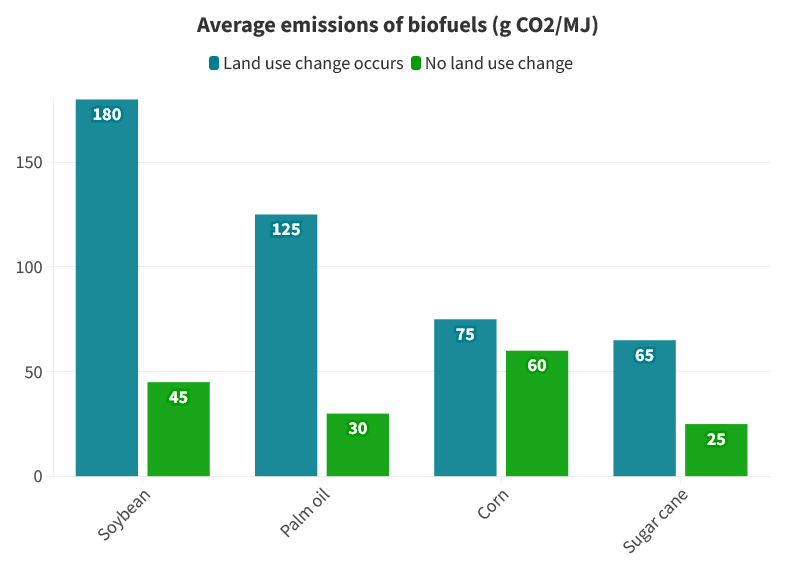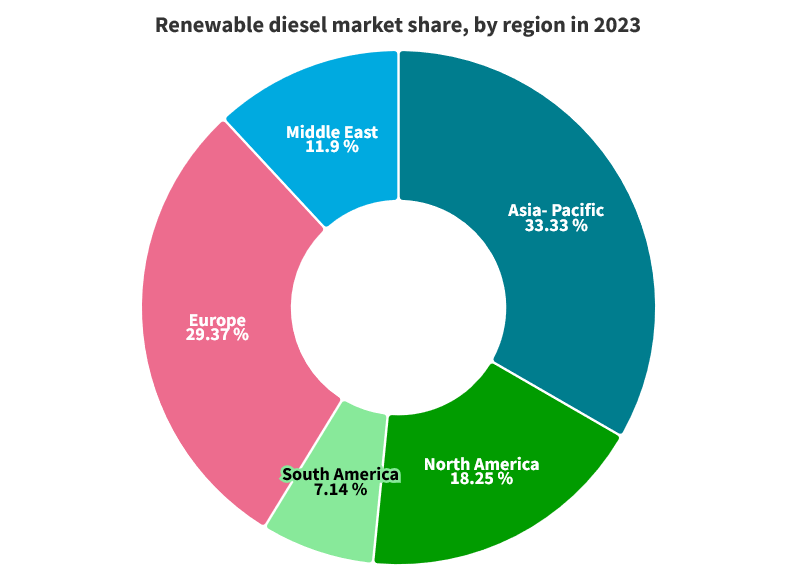Fueling sustainably: the ultimate guide to renewable diesel vs biodiesel
As economic, social, and regulatory pressures continue to rise, the search for alternatives to petroleum-based fuels is more prominent than ever. The current debate revolves around renewable diesel vs biodiesel—both viable options but understanding their differences is crucial.
Biodiesel and renewable diesel have demonstrated comparable or superior performance to traditional petroleum diesel, each possessing unique strengths and weaknesses. However, biodiesel probably has the advantage of being more well-known in the market.
Biodiesel production
Biodiesel production is expected to have a steady growth, going up from approximately USD 39.25 billion in 2023 to USD 79.12 billion in 2032 (Figure 1).

In 2022, Indonesia continued its dominance on the global stage, representing approximately 13.65 billion liters of production (Figure 2).
Following behind, Brazil and the U.S. contributed approximately 6.77 and 6.14 billion liters, respectively. Germany became the primary producer in Europe, with around 4.01 billion liters, securing a spot among the top four countries in the global production landscape.

The source of biodiesel is another crucial decision and topic of discussion. In the U.S., production primarily relies on vegetable oils, particularly soybean oil, as the main feedstocks. Other significant feedstocks include animal fats, as well as used cooking oil. Meanwhile, in other countries, major feedstocks for biodiesel production includes oils from rapeseed, sunflower, and palm.
Challenges in land use due to biofuels
Biofuels, such as bioethanol, biodiesel, renewable diesel, and sustainable aviation fuels serve as a versatile energy source for vehicles, heating, and electricity. However, meeting the growing demand would need a significant expansion in the land devoted to their production.
In Europe, an area comparable to the size of Ireland is dedicated to cultivating crops for biofuels, which poses challenges to addressing climate change and food security. This land could potentially feed 120 million people if utilized for food production.
If left in its natural state, it could eliminate double the amount of CO2 emitted from powering cars with biofuels. Interestingly, using only 2.5% of this land for solar panels could yield equivalent energy output.
Related: Solar energy facts: a win-win for businesses and the planet
Maik Marahrens, the biofuels manager at T&E, expressed his viewpoint, stating, "The utilization of biofuels has proven to be unsuccessful. The practice of using food for fuel instead of addressing the global food shortage is morally questionable. It's encouraging to see countries such as Germany and Belgium contemplating restrictions on food crop biofuels, and the rest of Europe needs to take similar actions."
The challenges arise due to practices like land clearing, including deforestation, which is essential for cultivating these crops. The average emissions considering land use change and no land use change are shown in Figure 3.

Forests serve as highly efficient systems for absorbing CO2 from the atmosphere, even more than the crops. This means substituting forests with crops decreases the amount of CO2 absorbed.
As a result, Brazil, a significant producer of biodiesel has experienced a reduction in production this year due to successive droughts impacting soybean and corn yields. However, few countries have taken action regarding this situation. Germany, for example, has banned biodiesel production from palm oil starting in 2023 due to deforestation concerns.
Renewable diesel vs biodiesel: what’s the difference?
Biodiesel and renewable diesel have comparable physical characteristics and applications to traditional petroleum distillate fuels. The key advantage of renewable diesel lies in its independence from fossil fuels but here are the key differences between renewable diesel vs biodiesel.
Biodiesel undergoes production via a process called transesterification, where oils and fats are purified. These are then blended with petroleum diesel at various ratios from 5% to 20%. However, this blending technique carries the potential risk of engine damage and leads to increased levels of NOx emissions.
Renewable diesel is manufactured through a process known as hydrotreating. This method involves hydrogenating triglycerides (fats) to eliminate metals and compounds. It runs efficiently in all vehicles without requiring upgrades to existing refinery equipment for its production.
Renewable diesel represents the cleaner choice as it can seamlessly replace fossil diesel due to them being chemically identical. In contrast, biodiesel, while a sustainable alternative to petroleum diesel, falls short in this case.
Related: Renewable energy investments call for stronger commitment to net-zero initiatives
Environmental effects of renewable diesel vs biodiesel
A primary concern associated with biodiesel consists of the transesterification process, where the conversion of fats from oils into biodiesel introduces oxygen into the fuel.
This oxygen content leads to challenges such as freezing temperature issues, separation during storage, the promotion of algae growth, and an upsurge in emissions. These aspects need careful consideration when storing and utilizing the fuel. Also, biodiesel used in vehicles tends to release more pollutants into the environment.
In contrast, renewable diesel does not incorporate any oxygen, eliminating concerns about storage and temperature issues. Additionally, the hydrogenation process makes the combustion cleaner than both biodiesel and traditional fossil fuel-based diesel.
Related: Green hydrogen companies are assets to the sustainable energy future
Global renewable diesel market
The worldwide market is on the verge of a significant transformation, driven by its environmental benefits and the escalating energy demand.

As per recent market analysis, the distribution of global renewable diesel was outlined among various end-users, as illustrated in Figure 4. The transportation sector, including automotive, aviation, and marine industries, emerges as the primary consumer.
Fleet operators and transportation companies are transitioning to renewable diesel due to its seamless compatibility with existing infrastructure and engines, eliminating the need for significant modifications.

In the global landscape, the renewable diesel market is significantly influenced by the Asia Pacific, Europe, and North America region (Figure 5). Leading manufacturers in the renewable diesel market are channeling efforts into research and development to enhance production processes and broaden feedstock options.
As of now, advanced conversion technologies like hydrotreating and the Fischer-Tropsch (FT) process are efficiently employed to convert a diversified range of feedstock choices, including used cooking oil and algae, resulting in increased production capacity. With this, despite facing challenges in quality control, the industry's prospects seem promising as they align with global sustainability objectives.
Have some feedback or want to sponsor this newsletter?
Thank you for reading. If you liked this post, please click the ❤️ button. That would improve my visibility. If you love The Green Solutions, would you share your experience with a quick text testimonial by clicking here? Thank you very much.




